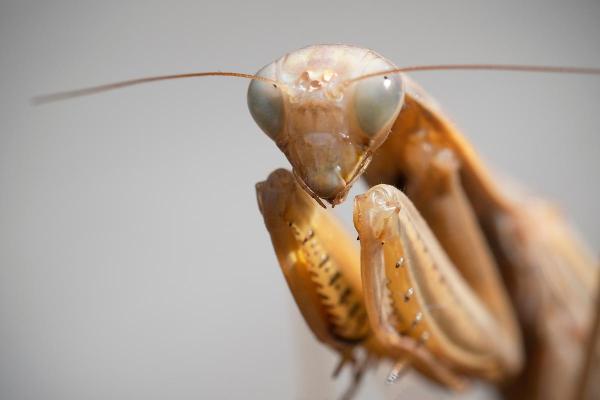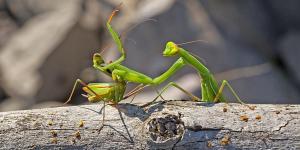Is the Praying Mantis Poisonous?


The praying mantis is a fascinating insect that is known for its predatory nature. These insects are often feared for their sharp claws and fearsome appearance. In fact, some people believe that praying mantises are poisonous, but this is a common misconception. In fact, praying mantises do not have venom glands and their bite is not poisonous to humans.
In this AnimalWised article, we will take a closer look at the anatomy of the praying mantis and discuss if praying mantises are poisonous to humans. We will also explore the effects of the praying mantis bite on humans.
What are praying mantises?
Praying mantises are fascinating insects that are instantly recognizable thanks to their elongated bodies, triangular heads, and powerful front legs. These legs are specifically designed for hunting, and they allow praying mantises to catch and subdue their prey with ease.
Praying mantises are found all over the world and come in a variety of sizes and colors. They are predators and eat a variety of insects, including flies, crickets, and butterflies. They are also known for their cannibalistic behavior, with the female praying mantis often eating the male after mating.
Praying mantises trace their origins to around 150-200 million years ago during the Jurassic period. They belong to the order Mantodea and evolved from early mantis-like insects. Over time, they developed distinctive features like elongated bodies and powerful front legs specialized for hunting.
Praying mantises are solitary predators that excel in stealthy hunting. They prefer habitats like gardens, fields, and forests where they can readily find their prey. Their patient and calculated approach to hunting makes them masters of deception, lurking among vegetation until the perfect moment to strike.
Beyond their captivating appearance and behaviors, praying mantises play a vital role in ecosystems. They serve as natural pest controllers, helping to keep insect populations in check. Their presence contributes to the balance of ecosystems and supports biodiversity.
Praying mantises hold cultural significance in many societies and continue to be subjects of scientific study due to their unique predatory behaviors and evolutionary success.

Are praying mantises poisonous to humans?
Praying mantises are fascinating insects that are often feared for their predatory nature. However, these insects are generally harmless to humans. Unlike some other predatory insects, praying mantises do not have venom or poison glands.
They rely on their physical hunting prowess to survive. They are adept hunters, using their agility and speed to capture prey rather than relying on venom. Their remarkable front legs, known as "raptorial legs," are specifically designed for catching and restraining prey.
These insects are primarily carnivorous, with a diet that includes a wide range of insects such as flies, crickets, butterflies, grasshoppers, and smaller insects. Praying mantises often patiently stalk their potential prey, waiting for the right moment to strike. When they detect potential prey, they use their front legs with incredible precision to grasp and immobilize it. They then consume their prey alive, typically starting with the head before moving on to the rest of the body.
You might be interested in this other article, where we discuss if insects have brains.
Do praying mantises sting or bite?
While praying mantises do not have venom, they can bite if they feel threatened. However, their bites are not typically harmful to humans. The bite of a praying mantis feels like a pinch and may cause minor skin irritation.
When faced with a perceived threat, praying mantises are more inclined to flee or use their distinctive front legs for defense rather than resorting to biting. Praying mantises bite as a defensive mechanism. They may bite if they feel threatened or if they are being handled roughly.
Unlike creatures like bees or scorpions, which rely on venomous stings for defense, praying mantises have evolved differently. Their jaws are primarily adapted for hunting smaller insects like flies, crickets, and butterflies. Consequently, any attempts to bite are generally feeble and unlikely to cause harm.
To avoid being bitten by a praying mantis, it is important to handle them gently and respectfully. Do not pick them up by the abdomen, as this can make them feel threatened. If you are approached by a praying mantis, it is best to leave it alone.

Why don't praying mantises have poison?
As mentioned before, praying mantises are exceptional visual predators, relying on their sharp vision and lightning-fast movements to detect and capture insects both in flight and on the ground with remarkable precision. Their hunting prowess is so impressive that they can snatch insects right out of the air.
The eyes of a praying mantis are remarkable, among other things, for their binocular vision, which allows them to focus on an object with both eyes simultaneously, accurately gauging distances and tracking prey. Their large compound eyes provide excellent visual acuity and depth perception. This, combined with their ability to rotate their heads, gives them a wide field of vision and the advantage of 3D-like vision. Praying mantises can also perceive some colors and ultraviolet light. These specialized eyes contribute to their success as ambush predators.
The absence of venom in praying mantises is attributed in part to the sheer effectiveness of their hunting method. By using their raptorial legs, they secure their prey firmly in place before consumption. Unlike other creatures that rely on venom to immobilize or digest their victims, praying mantises employ their speed, precision, and strength to subdue their prey directly and efficiently.
Praying mantises are also masters of disguise, employing camouflage and mimicry to blend seamlessly with their surroundings. Some species resemble leaves or twigs, allowing them to ambush unsuspecting prey.
This poison-free hunting strategy reflects not only the effectiveness of their approach but also the evolution of their anatomy and behavior over millions of years. Praying mantises have developed specific adaptations that enable them to excel in hunting without resorting to toxicity. Their aggressive hunting tactics and stalking abilities showcase their exceptional adaptation to their ecological niche.
To learn more about other big-eyed animals like the praying mantis, check out this other article.
Can you keep a praying mantis as a pet?
Praying mantises are fascinating insects that can make great pets for insect enthusiasts. They are relatively easy to care for and require a simple setup. Here are some key points to consider when keeping a praying mantis as a pet:
- Species: there are many different species of praying mantises, each with its own unique characteristics and care requirements. Do some research to choose a species that is right for you.
- Habitat: praying mantises need a spacious enclosure with plenty of hiding places. A small aquarium or a specially designed mantis habitat with proper ventilation is ideal. Make sure the enclosure has a secure lid to prevent escapes.
- Temperature and humidity: praying mantises thrive in a temperature range of 70-85°F (21-29°C) and moderate humidity levels. You may need to provide a heat source, such as a low-wattage heat lamp, to maintain the proper temperature.
- Feeding: mantises are carnivores and need to be fed live insects. Their diet can include fruit flies, crickets, small moths, and other appropriate prey. Make sure the prey is the right size; it shouldn't be larger than the mantis's head.
- Handling: praying mantises are fragile creatures, so handle them with care. Avoid excessive handling, which can stress them. Use a gentle touch and avoid touching their abdomens.
- Cleaning: regularly clean the enclosure by removing uneaten prey and waste. Praying mantises can be messy eaters.
- Molting: mantises molt as they grow, shedding their exoskeletons. During this period, they are vulnerable, so avoid disturbing them. Provide a safe and undisturbed space for molting.
- Lifespan: the lifespan of a praying mantis varies by species, but generally ranges from a few months to a year or more.
- Breeding: if you are interested in breeding mantises, you will need separate enclosures for males and females. Mating can be risky for the males, so it is important to research the specific breeding requirements of your chosen species.
- Legality: before acquiring a praying mantis as a pet, check your local and national laws and regulations. Some species may be protected or restricted in certain areas.
By following these tips, you can provide your praying mantis with the proper care and ensure that it has a long and healthy life.
Check out the video below to learn more about the fascinating facts of praying mantises.

If you want to read similar articles to Is the Praying Mantis Poisonous?, we recommend you visit our Facts about the animal kingdom category.
- Carle, T., Horiwaki, R., Hurlbert, A., & Yamawaki, Y. (2018). Aversive learning in the praying mantis (Tenodera aridifolia), a sit and wait predator . Journal of insect behavior, 31, 158-175.
- Lawrence, S. E. (1992). Sexual cannibalism in the praying mantid, Praying mantis: a field study . Animal Behavior, 43(4), 569-583.
- Maldonado, H., Levin, L., & Pita, JB (1967). Hit distance and the predatory strike of the praying mantis . Zeitschrift für vergleichende Physiologie, 56, 237-257.
- Prete, FR, Klimek, CA, & Grossman, SP (1990). The predatory strike of the praying mantis, Tenodera aridifolia sinensis . Journal of Insect Physiology, 36(8), 561-565.
- Ramesh, A., Vijayan, S., Sreedharan, S., Somanathan, H., & Uma, D. (2016). Similar yet different: differential response of a praying mantis to ant-mimicking spiders . Biological Journal of the Linnean Society, 119(1), 158-165.







